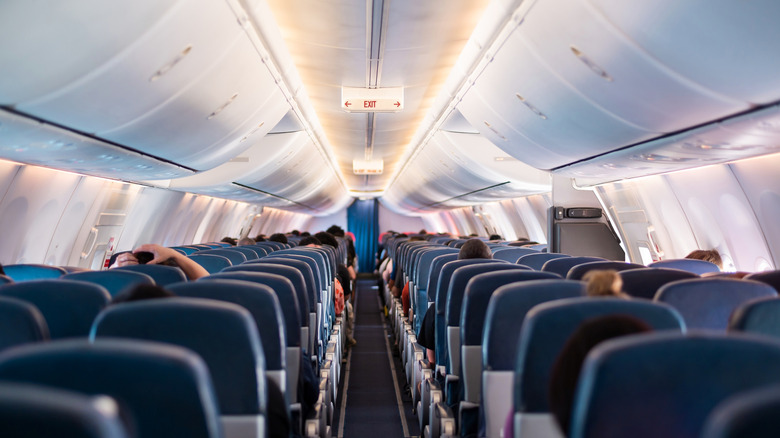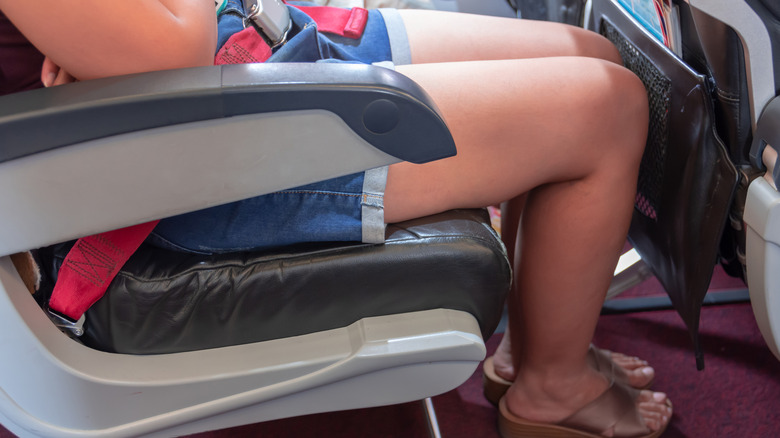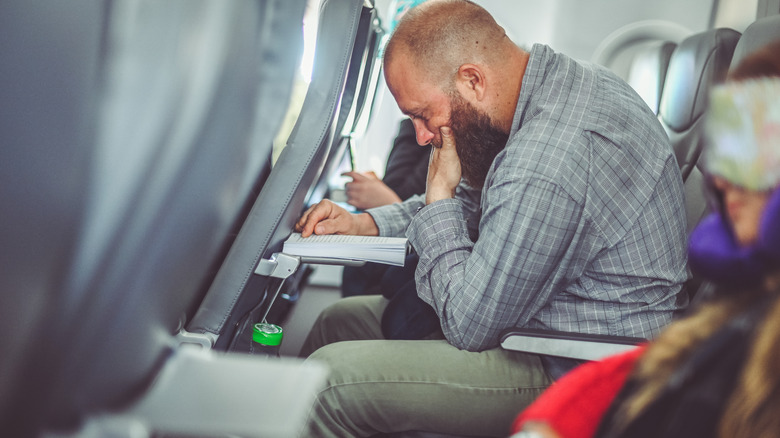Why Your Experience On Planes Is Getting More And More Uncomfortable
Once upon a time, airlines used to do everything possible to make the journey one to remember. At the airport, courteous porters whisked their luggage to the plane so they could proceed unencumbered to the boarding area — without ever removing their shoes. If they wanted a particularly festive send-off, friends and family could join them at the gate for a celebratory bon voyage.
There was no jockeying for position at the jetway door. There was plenty of time and plenty of room for everyone. Once on board, they settled into roomy seats with enough space between rows to comfortably cross their legs. It probably sounds like the stuff of fairy tales to anyone born in the 21st century, but it's all true. Long before boarding became a race to snag an overhead bin and cramped seating configurations led to passengers engaging in a passive-aggressive stand-off over who owns the air space between rows, air travel was a reasonably pleasant experience, something to be enjoyed rather than endured.
What happened? Well, as the novelty of air travel began to wear off and flying became accessible, airlines came up with creative ways to wring profits from cost-conscious passengers. They squeezed more bodies into the main cabin, ended complimentary in-flight meals, and stuck airfare bargain hunters in the most undesirable of the undesirable seats. As the average size of a seat in economy class continues to shrink, this problem only seems to be getting worse.
Are economy seats getting smaller?
Let's talk about seats. Yes, people might be getting bigger, taller, and wider, but that only compounds the issue of the shrinking airline seat. In 2018, Bill McGee (former editor of the Consumer Reports Travel Newsletter) wrote an article for USA Today about the diminishing size of airline seats. McGee, a consumer advocate with decades of experience covering the airline industry, poured through Consumer Travel Reports going back to 1985 to compare average seat dimensions over time. The results weren't great, to say the least.
Focusing on the economy-class cabins of four major U.S. carriers — American, Delta, United, and Southwest Airlines — McGee's research revealed that seat width had dropped from a low of 19 inches in the 1990s to 17 inches in 2014. Then, there's pitch, the measurement of space between one point on a seat to the same point on the seat in the next row, and the root of the recline-or-don't-recline etiquette debate. At the time of McGee's article, that space had decreased over time from an average of 35 inches in 1985 to 31 to 32 inches by 2014.
The ever-shrinking pitch
An intentional pain point? Maybe. Here's the tricky thing about pitch. It's a no-win situation for passengers. Look closely at almost any airline cabin configuration, and it's clear carriers are playing both sides against the middle, selling the space in question to two passengers. The person seated in front paid for a seat that reclines, and the passenger in back paid for a seat with enough space to comfortably use the drop-down tray. When the person in front reclines (as is their right), the seat back encroaches on the space allotted to the passenger behind them. The only winner is the airline that makes at least one passenger uncomfortable enough to vow never again and pony up an extra fee for more space on their next flight.
And the shrinkage may not be over yet. In 2023, the Federal Aviation Association declined to comment on a petition filed by FlyersRights, an airline passenger advocacy group. In the petition, FlyerRights asked the FAA to set standards for minimum airline seat dimensions with an eye toward ensuring health and comfort standards for 90% of the traveling public. The FAA denied the request, claiming that current, unregulated seat dimensions do not compromise aircraft passenger safety evacuation protocol. What's next? Only time will tell. In the meantime, it may be wise to savor whatever limited space your current main-cabin airline seat may offer because there's a decent chance these are the good old days. The concept of even more restrictive stand-up — and even stacked — seating has already been floated by some economy carriers. Can the legacy airlines be far behind? It might be time to read up on the best ways to get more leg room in the skies.


